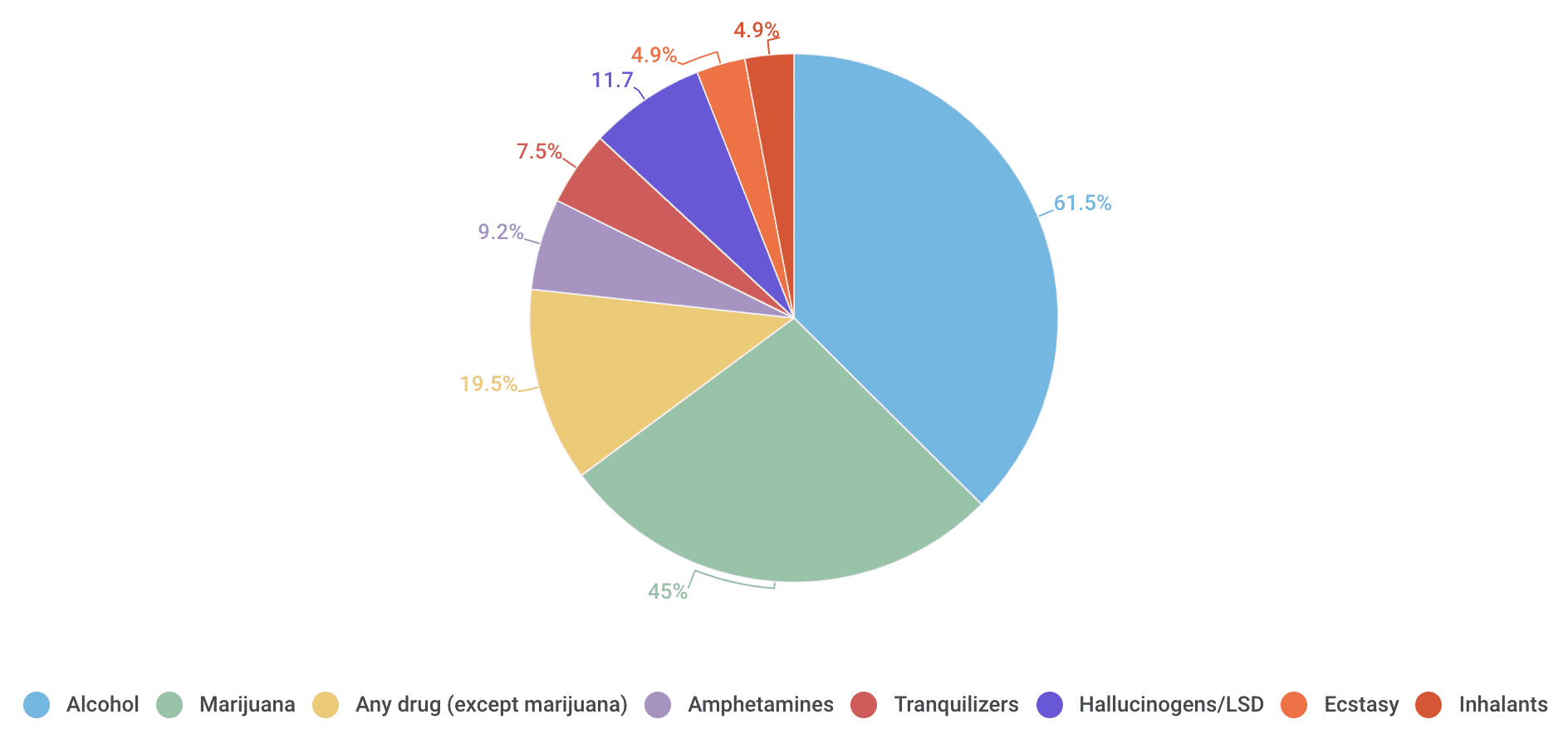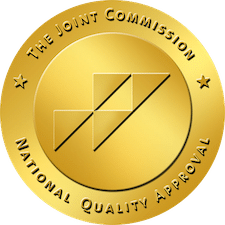
Teen Drug Use: Commonly Abused Drugs
As of 2019, the number of teenagers who use drugs continued to decline each year for almost a decade.1 However, adolescents who continue to experiment with and abuse drugs are at great risk for developing a substance use disorder or addiction.2 It is vital for parents of teenagers to understand teen drug use, how it affects their developing brains, how to talk to them about drugs, signs associated with teen drug abuse, and the most effective treatment options available to them.
Table of Contents
Teen Drug Use Statistics
An annual 2017 survey found that past-year illicit drug use (other than marijuana) were at the lowest levels in over two decades. Results for past-year illicit drug use in 2017 was 5.8% among 8th graders, 9.4% among 10th graders, and 13.3% among 12th graders. Peak rates were 13.1 for 8th graders in 1996, 18.4% for 10th graders in 1996, and 21.6% for 12th graders in 2001.2

Although there has been a decline in teenage illicit drug use, adolescent perceptions of potential dangers associated with drugs have also declined. The percentage of middle school and high school individuals who view certain drugs as dangerous and harmful is lower than it has been in recent years.2
Also, despite the overall decline in teenagers’ illicit drug use, almost half of all college students have used drugs in their lifetime. In 2016, 45% of male college students and 42% of female college students reported having used an illegal drug. 2
Additionally, the need for substance abuse treatment for young people in the United States is exceptionally high. Ten million young people aged 12 to 29 require substance abuse treatment, and only 1 in 10 adolescents who have a substance use disorder receive the treatment they need.2
Substance use can have a severe impact on a teenager’s development and overall health and wellbeing. The American Academy of Pediatrics (AAP) and the Centers for Disease Control and Prevention (CDC) have developed a guide for substance abuse screening in pediatric practices so pediatricians can effectively address substance use concerns. The AAP recommends beginning the screening process at nine years of age. 3
Drugs Commonly Used by Teens
Substance use can have a severe impact on a teenager’s development and overall health and wellbeing. The American Academy of Pediatrics (AAP) and the Centers for Disease Control and Prevention (CDC) have developed a guide for substance abuse screening in pediatric practices so pediatricians can effectively address substance use concerns. The AAP recommends beginning the screening process at nine years of age. 3
While teenage drinking trends have declined in the past six years, heavy drinking is still prevalent among younger drinkers. People who drink underage consume more alcohol on each drinking occasion than adult drinkers, and almost 20% of college students struggle with alcohol abuse. Additionally, 74% of adults who participate in a substance abuse treatment program began using drugs and alcohol before turning 17.2
In 2019,
- 7.9% of 8th graders
- 18.4% of 10th graders
- 29.3% of 12th graders
Reported using alcohol in the past month. In the same year,
- 3.8% of 8th graders
- 8.5% of 10th graders
- 14.4% of 12th graders
Reported binge drinking. Binge drinking is defined as drinking five or more alcoholic drinks in a row within the past two weeks. Additionally,
- 24.5% of 8th graders
- 43.1% of 10th graders
- 58.5% of 12th graders
Reported ever having used alcohol.1
Drinking can be extremely hazardous for young people. Those who start drinking at a young age are seven times more likely to be in a motor vehicle accident involving alcohol when they begin to drive. Additionally, 97,000 students between 18 and 24 are sexually assaulted in an incident where alcohol is involved.2
Marijuana can also be detrimental to young people. Individuals who start using marijuana as a teenager or younger are more likely to experience adverse effects over time than older people who use marijuana. One in six people who begin using marijuana as a teen, and 25-50% of those who use it daily, develop an addiction. Additionally, teenage girls ages 14-15 who used the drug daily were five times more likely to experience depression at age 21.2
In 2019,
- 6.6% of 8th graders
- 18.4% of 10th graders
- 22.3% of 12th graders
Reported using marijuana in the past month. In the same year,
- 11.8% of 8th graders
- 28.8% of 10th graders
- 35.7% of 12th graders
Reported using marijuana in the past year. Additionally,
- 86.4% of teenagers
Daily marijuana use, defined as use on 20 or more occasions in the past 30 days, increased among teenagers in 2019. A total of 1.3% of 8th graders, 4.8% of 10th graders, and 6.4% of 12th graders reported daily use. These numbers represent an 85.7% increase among 8th graders and a 41.2% increase among 10th graders compared to 2018.1
In the year 2019, there was a significant increase in vaping in all grade levels. In 2019, past month use of vape products increased from 21.7% to 25% among 10th graders, and from 26.7% to 30.9% among 12th graders. These percentages equate to one in four 10th graders and one in three 12th graders who currently use vape products. Most teens use JUUL products, and 82% of 12th graders have said it is easy to obtain vaping devices.1
In 2019,
Nicotine vaping increased by
- 9.6% among 8th graders
- 19.9% among 10th graders
- 25.5% among 12th graders
Marijuana vaping in 2019 increased from
- 2.6% to 3.9% among 8th graders
- 7% to 12.6% among 10th graders
- 7.5% to 14% among 12th graders
The misuse of prescription drugs, which includes opioids, is one of the fastest-growing drug problems in the United States. Opioid use, in general, is decreasing but is still the cause of significant addiction issues.2
In 2019,
- 2.7% of 12th graders reported using opioids
Meanwhile,
- 1.1% of 10th graders
- 1.1% of 12th graders
Reported using Vicodin. Additionally,
- 1.7% of 12th graders reported using oxycontin
- 0.3% of 10th graders
- 0.4% of 12th graders
Dying from an overdose is the most severe consequence that can occur as a result of misusing prescription drugs. While the number of overdose deaths is low overall, the rate is increasing among adolescents. In 2015, 4,235 young people aged 15-24 died from a drug-related overdose, and over half of these deaths involved opioids. According to the CDC, for every young adult who dies from an overdose, there are 119 emergency room visits and 22 treatment admissions.2
Effects of Drugs on Developing Brains
The brain consists of many parts that work together to ensure proper functioning. Each part of the brain has its own specific and essential duty. When drugs enter the system, they can interfere with the brain’s regular activity and ultimately lead to changes that affect how well the brain works.4
When drugs enter the body, they interfere with the brain’s communication system and change how nerve cells send, receive, and process information. Different drugs affect the brain in different ways. They affect the brain by imitating the brain’s natural chemical messengers or overstimulating its reward system.4
Drugs like marijuana and heroin mimic the brain’s naturally occurring neurotransmitters. These drugs fool receptors and latch onto them, activating the nerve cells. They work differently than the brain’s natural neurotransmitters, which causes neurons to send abnormal messages throughout the brain.4
Drugs like cocaine and methamphetamine cause nerve cells to release an excess of dopamine or prevent the regular recycling of dopamine, a natural neurotransmitter in the brain. This change in dopamine causes exaggerated messages in the brain and alters communication channels.4
The brain’s reward system typically responds to healthy, pleasurable activities by releasing dopamine, increasing someone’s desire to repeat those activities. Some drugs take control of this system and release excessive amounts of dopamine in response to the drug itself and other cues associated with taking the drug. The brain remembers this pleasurable feeling and sends out signals that motivate someone to seek out and use the drug again. Thus, dopamine reinforces someone’s desire to continue using a particular drug.4
Repeated drug use can cause the brain to eventually adjust to dopamine surges, causing neurons to reduce the number of dopamine receptors or produce less dopamine. This change in dopamine levels lessens someone’s ability to feel pleasure from everyday activities and causes them to feel lifeless or depressed. At this point, the individual has developed a tolerance and will need to use drugs to feel normal.4
Long term and chronic use can eventually lead to drastic changes in neurons and brain circuits. These changes can continue to affect someone even after they stop taking the drug.4
Adolescents are uniquely susceptible to the short-term and long-term effects of drugs on the brain. When drug use begins at a young age, it can alter brain maturation, contribute to long-term cognitive impairment, and significantly increase someone’s susceptibility for developing a substance use disorder.5
How to Talk to Your Teenage About Drugs
It is essential to talk to your teenagers about drugs and the dangers of adolescent drug use. However, it is necessary to go about it in a way that will encourage your teenager to avoid rather than engage in substance use.6
One study found that it can be counterproductive to set rules against drug use and utilize negative or critical parenting styles when conversing with your teenager about substances. These conversations may increase their discomfort and may inevitably result in them using substances.6
It is best to engage your teenager by discussing hypothetical scenarios that may result from drug use or talking about what they have learned in school about drugs. This type of communication can reduce their discomfort and perhaps prevent substance use. It is most useful for parents to discuss scenarios with their teenagers rather than criticize and set rules against drug use.6
Drug Experimentation vs. Addiction
It is important to understand that drug experimentation is not harmless, healthy, or normal for teens. Social drugs like alcohol and marijuana can have severe consequences and are especially problematic for the developing adolescent brain. Experimentation is not inevitable, as nearly half of all high school students graduate without ever having used illicit drugs.7
Your teenager may choose to experiment with drugs. It is important to note that experimentation does not always lead to addiction. There are signs to look out for when determining whether your adolescent loved one is struggling with drug abuse.
Signs of Teenage Drug Abuse
There are several warning signs that your teenager may exhibit when they are abusing illicit drugs. You should always take these signs seriously, as they could mean that your child is developing or has developed a substance use disorder or addiction.8
Signs of drug use include:
- Behavioral changes (including violence)
- Changes in friend groups
- Withdraw from family activities
- Impaired judgment
- Slurred speech
- Lack of motivation
- Stealing
- Lack of hygiene
- Personality changes
- Lying
- Depression
Addiction Treatment Options for Teens
The most effective treatments for adolescents struggling with a substance use disorder or addiction include ecological family-based treatment, group cognitive-behavioral therapy (CBT), and individual CBT. Behavioral family therapy and motivational enhancement therapy can also help treat adolescent substance use disorders and addiction.10
The combination of these treatment approaches and treatment approaches that address multiple disorders can enhance the effectiveness of treatment for young people. Specifically, the combination of MET and CBT, and MET, CBT, and behavioral family-based therapy are very effective.10
Many outpatient and inpatient treatment centers utilize a combination of these treatment methods. An inpatient treatment that offers various treatment approaches may be the most effective for your teenager, as it removes the adolescent’s access to substances.
References & Resources
- NIDA. 2019, December 18. Monitoring the Future Survey: High School and Youth Trends DrugFacts. Retrieved from https://www.drugabuse.gov/publications/drugfacts/monitoring-future-survey-high-school-youth-trends
- Teenage Drug Use Statistics [2020]: Data & Trends on Abuse. (2020, January 22). Retrieved from https://drugabusestatistics.org/teen-drug-use/
- Teen Substance Use & Risks. (2020, February 10). Retrieved from https://www.cdc.gov/ncbddd/fasd/features/teen-substance-use.html
- NIDA. 2020, September 9. Brain and Addiction. Retrieved from https://teens.drugabuse.gov/drug-facts/brain-and-addiction
- Winters, K. C., & Arria, A. (2011). Adolescent Brain Development and Drugs. The prevention researcher, 18(2), 21–24.
- Chaplin, T. M., Hansen, A., Simmons, J., Mayes, L. C., Hommer, R. E., & Crowley, M. J. (2014). Parental-adolescent drug use discussions: physiological responses and associated outcomes. The Journal of adolescent health : official publication of the Society for Adolescent Medicine, 55(6), 730–735. https://doi.org/10.1016/j.jadohealth.2014.05.001
- Teen Drug Use: A Phase or Growing into an Addict. (2013, October 08). Retrieved from https://www.psychologytoday.com/us/blog/where-science-meets-the-steps/201310/teen-drug-use-phase-or-growing-addict
- Ali, S., Mouton, C. P., Jabeen, S., Ofoemezie, E. K., Bailey, R. K., Shahid, M., & Zeng, Q. (2011). Early detection of illicit drug use in teenagers. Innovations in clinical neuroscience, 8(12), 24–28.
- NIDA. 2020, July 14. What are signs of drug use in adolescents, and what role can parents play in getting treatment?. Retrieved from https://www.drugabuse.gov/publications/principles-adolescent-substance-use-disorder-treatment-research-based-guide/frequently-asked-questions/what-are-signs-drug-use-in-adolescents-what-role-can-parents-play-in-getting-treatment
- Gray, K. M., & Squeglia, L. M. (2018). Research Review: What have we learned about adolescent substance use?. Journal of child psychology and psychiatry, and allied disciplines, 59(6), 618–627. https://doi.org/10.1111/jcpp.12783
